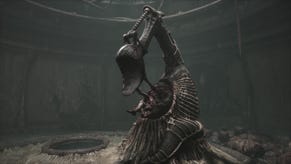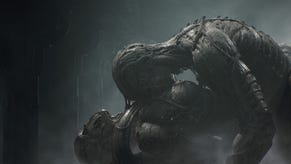Scorn on Xbox Series X: our first look at AMD's FSR 2 on consoles
Smart upscaling to 4K for the top-tier Xbox - but what about Series S?
Scorn is one of the most visually distinctive games released in recent times. Clearly inspired by the work of HR Giger, the game's environments marry mechanical intricacy with biology to create a highly unnerving experience. It's sci-fi, but not hi-tech, with analogue mechanics, skeletal metalwork, and the occasional glimpse of something truly alive.
On the surface, Scorn looks like a first-person shooter, but it has more in common with Myst or The Witness than Doom. This is a slow-paced, brooding title that requires puzzle-solving and careful exploration - but with a small team at the helm and a nearly 10-year development cycle, is this Unreal Engine 4-based game properly polished? And on Xbox Series X, just how good is AMD's FSR 2 image reconstruction?
Scorn's visual design is pitch-perfect from the moment you look at the title screen. The environments are highly ambiguous - vaguely mechanical, but ribbed with bone-like arches and inlaid with vascular tubing. Everything is dilapidated, worn and glistening with moisture. But some mechanisms still seem to work, and hint at some larger, unknown purpose. As you progress, the organic elements take over, with guts and veins splayed out all around. Humanoid creatures can be found, fused into bizarre arrangements or discarded like trash. Your character is no different - shortly into the game, you're attacked by a parasite, which slowly envelops you. The game's style is strange, uncomfortable, and wholly unique in gaming.
Expect to see unique and breathtaking artwork for every location in the game. Decaying ceilings with light flooding in, elaborate contraptions surrounded in mist, a temple criss-crossed by webs of flesh - it's all eye-catching and visually compelling. So much care and attention to detail has been packed into every space. All that artwork would be for naught if the technology wasn't there to back it up, of course. Scorn benefits a lot from its restricted scope and reliance on static opaque models to really ramp up the overall level of fidelity. There's a ton of geometry carved into every surface, for instance. The level of consistency is really something here, particularly for a smaller-budget game. Maps are ornate and detail-rich in a way that few other games can match.
But that's not to say that everything is perfect. For starters, even though Scorn is a current-gen exclusive - released on Series S, Series X, and PC - the overall visual impression is definitely of a last-gen game, albeit an excellent-looking one. Don't expect anything in the way of boundary-pushing rendering features like ray tracing, for example, and while environments do look very dense at reasonable distances, at point-blank range you can see the limitations of traditional geometry meshes, especially those that were designed around the constraints of older hardware platforms.
Resolution metrics are actually pretty simple on the surface: Series S renders at 1080p internally, while Series X hits 1440p. I tested across a variety of scenes and couldn't find evidence of lower pixel counts, though dynamic resolution is a possibility. However, when I started to examine image quality more closely, I noticed a handful of oddities - factors that suggest the use of some truly cutting-edge technology.
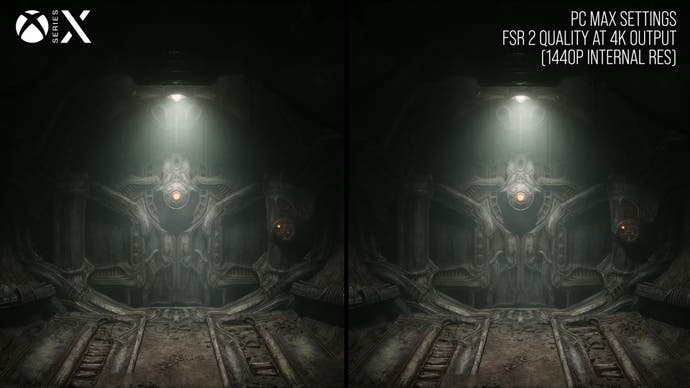

The first, most obvious clue is the difference in resolved detail between the two machines. While Series S seems very 1080p-like, Series X has an overall resolve that looks strikingly similar to 4K, even at very close viewing distances. Indeed, the presentation holds up well even against the fully maxed-out PC experience - with only small, artefact-ridden trails on particle effects. The issue here is that these elements don't have motion vectors, so certain temporal AA techniques can struggle with them at times.
The PC version supports reconstruction - but only AMD's FidelityFX Super Resolution 2 (FSR 2) and running that at quality mode produces an effect that's visually identical to Xbox Series S, right down to the same issues with particles. The stereotypical FSR 2 image quality flaw - significant disocclusion artifacting - is much harder to observe here on Series X, however. Typically FSR 2 presents with a sort of fizzling artifact pattern when certain screen elements are uncovered. There is some disocclusion artifacting on Xbox Series X, but it tends to be pretty mild.
I do think that there are a few key factors that make disocclusion less of an issue in this particular game though. Scorn has a first-person perspective without complex animation, a low-contrast visual style, and a lot of film grain, which can't be turned off. Ultimately, the game's first-person perspective and specific aesthetic are an excellent match for FSR 2 and as my work on the game reached its conclusion, I did actually receive confirmation from the developer that AMD's smart upscaler is in place on the Series X version.


Series S? It's a straight 1080p, with no obvious upsampling. The use of FSR 2 is significant, as this is to our knowledge the first deployment of FSR 2 in a console title. While there hasn't been any technical barrier precluding developers from using FSR 2 in console games since its release several months ago, development timelines have seemed to preclude its immediate integration in console software.
Performance-wise, Series S offers a virtually locked 60fps update throughout the run of play. Combat, cutscenes, exploration - it all runs without issue. I did notice that the junior Xbox would occasionally drop a single frame during traversal in more demanding environments but this wasn't a common issue and wasn't particularly noticeable.
Series X is largely the same - a generally solid 60fps with the odd duplicate frame. But there are a few areas where the game suffers from more serious frame-rate issues. The game's cutscenes can suffer from performance drops, including the opening sequence, which dips as low as 43fps. Combat can sometimes provoke a momentary frame-rate drop, particularly when alpha effects are onscreen. Lastly, there are a few instances where the environment itself was complex enough to cause a prolonged performance issue. It's important to stress that the Series X is at 60fps the overwhelming majority of the time, but these performance issues are curious.
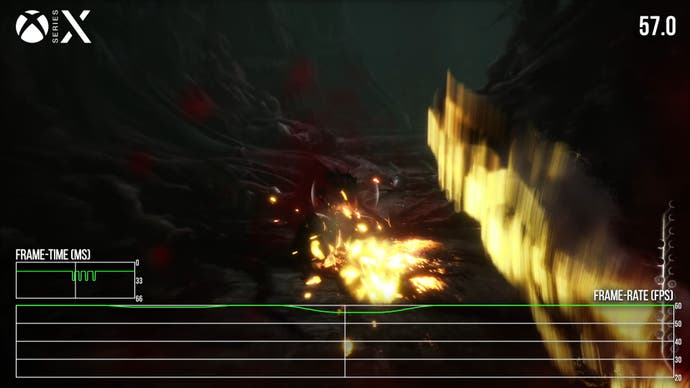
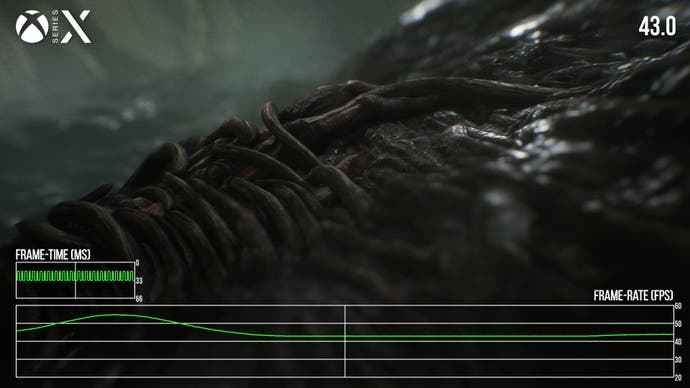
I say that because the Series X typically delivers a much larger resolution advantage over Series S than what we're seeing here. 1080p to 1440p is just a 78 percent improvement in raw pixel count, while 1080p to 4K or 1080p to 1800p is a more common divide in typical resolution between the two machines. There's no readily apparent difference in other visual settings between the consoles either - so what's going on?
Well, upsampling techniques do have a frame-time cost, and more advanced methods take more time to compute. FSR 2 can be particularly expensive and it's possible that it could take several milliseconds to compute per 4K frame on Series X. Within a 16.7ms frame, that's a pretty big chunk of time, which could explain why Series X falls behind Series S in performance despite only a moderate uptick in raw pixel count. It also hints at why we aren't seeing similar upsampling tech on the S - the computational cost may simply be too large. In short, high-end upscaling solutions like FSR 2 are clearly good for console gaming, but they come at a cost - there's no 'free lunch' in using them.
Returning to the game itself, Scorn isn't for everyone. It's cryptic, slow-paced, and very hard. You're dumped into a world without any instruction and expected to figure out how to progress with little in the way of clues. It bears some similarity to old-school adventure games, and is deliberately obtuse in much the same way. Plus there's no text, no dialogue, and a nearly non-existent plot. It's a great fit for Game Pass, as Scorn is a game that's well worth trying, but I suspect many players won't have the drive to progress very far. It's going to take a certain kind of gamer to really savour what this game has to offer - but those players will find a lot of visual rewards awaiting them. Scorn delivers a dense, beautifully designed world that often looks remarkable.







